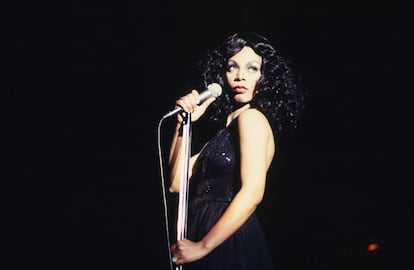The rise and fall of disco: From the dance floor to freedom
During the rough 1970s, people wanted to dance. The documentary ‘Disco: Soundtrack of a Revolution’ tells of how the genre grew on the margins, with Black women and gays at its helm, and how it wound up being eaten by its own success

The 1970s were a tough decade: when at last the Vietnam war ended, the oil crisis began. After the widespread upheavals of 1968, a conservative backlash took hold: in the United States, Nixon was in charge of the White House until the Watergate scandal. Racial segregation had ended, but only on paper: African Americans and Latinos continued feeling like second-class citizens. The Stonewall uprising, in New York, had brought to light the demands of the LGBTI community, even before it was called that, but no gay bar wanted to be the next site targeted, and the businesses largely sought to keep a low profile. The gay community was asked to refrain from dancing: it would draw too much attention to them.
Against this backdrop began to appear, on the margins of large North American cities, a dance floor movement that would give rise to disco. And, despite the fact that its image is now associated with frivolity and hedonism, it can also be looked at as a cultural phenomenon with strong political significance. Such is the position of the BBC’s three-episode docuseries Disco: Soundtrack of a Revolution. The tale is convincing, and includes great archival material, social context and voices of some of the era’s major players.
They were hard years, yes, and people wanted to dance, especially members of oppressed communities. One of the spaces they won for their freedom was the dance floor, not because they were able to be themselves while they were on it, but rather because they were able to be exactly who they wanted to be. With sequins, Afros, platform shoes, in costume, half-naked or in drag. That was liberating. Disco was born from other Black genres (soul, rhythm and blues, funk) and spread rapidly in venues frequented by homosexuals. The discotheques were an oasis of racial and sexual diversity. So much so, that trans women and drag queens were not only waved in to parties, their presence was very much in demand.
Disco’s electricity also became part of the feminist revolution, led in particular by Black women, who in many ways were relegated to the bottom rung of society: some became stars as shining as Gloria Gaynor and Donna Summer, or slightly-lesser deities like Patti Labelle, Candi Staton, Thelma Houston and Anita Ward. They put out anthems like I Will Survive, Don’t Leave Me This Way, Never Can Say Goodbye and Love to Love You Baby, which contained incredibly explicit messages of pride and celebration of difference, what today we would call empowerment. They continue to ring out over dance floors to this day.
The first of this kind of discotheques appeared in the basement of bars and in abandoned spaces (industrial warehouses, an old firehouse) in New York. The Loft and the Gallery were some of the spots were DJs first emerged, light bouncing off mirrored balls; massive parties took over nearby Fire Island and later, Studio 54, with its interminable lines to get in, and Paradise Garage rose to fame. The phenomenon quickly outgrew the Big Apple and reached Philadelphia (which had its own version: the Philadelphia Sound), Miami, Detroit and, notably, Chicago. DJs stopped merely playing records and became artists in their own right by creating original mixes. A few mythic names from these times: Larry Levan, David Mancuso, Nicky Siano and Frankie Knuckles. Dancing was so much more, it became an experience unto itself.
BBC’s documentary does a good job of explaining the culture’s rise and fall, its journey from the underground to the mainstream. In the second half of the ‘70s, radio gave into the phenomenon, as did industry charts and awards like the Grammys, gyms and dance schools offered classes to a public anxious to look good on the dance floor. The 1977 movie Saturday Night Fever was the turning point for disco, with John Travolta (white, heterosexual) as its flagbearer, and the music of the Bee Gees. Another reference from this moment is the Village People, who were recruited by a producer (“Macho Types Wanted: Must Dance And Have A Moustache”), and who had an aesthetic that parodied gay stereotypes (although the group’s singer, Victor Willis, was straight). The documentary is overly focused on the United States scene, and gives only a passing mention to European artists like Abba and Boney M., who had a similar impact on the other side of the Atlantic.
Disco achieved so many triumphs that it began to die from its own success. Record labels competed ferociously for the next pretty face, promoting disposable artists; unoriginal tracks multiplied like rabbits and were even played on children’s shows; rock stars like the Stones, Queen and Rod Stewart dipped toes into the genre. This produced a furious reaction within the United States’ dominant social group, heterosexual white men, who rallied behind the slogan “Disco Sucks”. Cheering on the revolt were rock radio announcers like Steve Dahl, who saw themselves as being displaced, their malcontent reaching such a volume that, at halftime of a Chicago White Sox baseball game in 1979, a coven of them destroyed thousands of the genre’s vinyls in the crowded stadium. It was Disco Demolition Night, and hatred for the music (run through with racism and homophobia) raged through the sporting arena until well into the early hours of the morning.
That wasn’t all. The final straw was the horrific eruption of HIV/AIDS in the early ‘80s, when it was referred to as “gay cancer”. Not only did the virus cause a wave of deaths (including those of many of the original disco DJs), the carnage intensified the stigmatization of homosexuals, with whom some people no longer wanted to dance. Radio and record companies began to bet on other genres, just as New Wave was emerging. Dance music, which assumed new terminology, didn’t die, but it returned to the margins. Knuckles invented house music at Chicago’s Warehouse club, and rave culture was incubated. All electronic music that was to come, and much of pop — everything we still dance to — is indebted to those divas, those DJs and those crowded dance floor that forever changed the nights (and days) of the rough ‘70s.
Sign up for our weekly newsletter to get more English-language news coverage from EL PAÍS USA Edition
Tu suscripción se está usando en otro dispositivo
¿Quieres añadir otro usuario a tu suscripción?
Si continúas leyendo en este dispositivo, no se podrá leer en el otro.
FlechaTu suscripción se está usando en otro dispositivo y solo puedes acceder a EL PAÍS desde un dispositivo a la vez.
Si quieres compartir tu cuenta, cambia tu suscripción a la modalidad Premium, así podrás añadir otro usuario. Cada uno accederá con su propia cuenta de email, lo que os permitirá personalizar vuestra experiencia en EL PAÍS.
¿Tienes una suscripción de empresa? Accede aquí para contratar más cuentas.
En el caso de no saber quién está usando tu cuenta, te recomendamos cambiar tu contraseña aquí.
Si decides continuar compartiendo tu cuenta, este mensaje se mostrará en tu dispositivo y en el de la otra persona que está usando tu cuenta de forma indefinida, afectando a tu experiencia de lectura. Puedes consultar aquí los términos y condiciones de la suscripción digital.
More information
Archived In
Últimas noticias
Most viewed
- Reinhard Genzel, Nobel laureate in physics: ‘One-minute videos will never give you the truth’
- Oona Chaplin: ‘I told James Cameron that I was living in a treehouse and starting a permaculture project with a friend’
- Pablo Escobar’s hippos: A serious environmental problem, 40 years on
- Chevy Chase, the beloved comedian who was a monster off camera: ‘Not everyone hated him, just the people who’ve worked with him’
- Why we lost the habit of sleeping in two segments and how that changed our sense of time











































